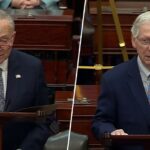In the days leading up to a critical funding deadline, House Speaker Mike Johnson (R-La.) is set to vote on a far-reaching continuing resolution (CR) that could stave off a partial government shutdown during the first 100 days of President Donald Trump’s term. With the deadline fast approaching on Friday, March 14, Congress faces immense pressure to act and ensure that federal agencies remain funded until September 30. In the absence of significant Democratic support, Speaker Johnson and his Republican colleagues are banking on the party’s internal cohesion to pass the 99-page CR largely along party lines. This article delves into the legislative process, the political strategy behind the bill, and the fiscal and policy implications of the proposed spending measures.
House Speaker Mike Johnson’s Strategy
House Speaker Mike Johnson (R-La.) has emerged as the central figure in the current funding debate. With a clear mandate to avert a government shutdown, Speaker Johnson is poised to cast his vote on Tuesday for the CR. In a political environment where bipartisan support is lacking, Johnson is confident that the Republican caucus can pass the measure on their own. His leadership is characterized by a willingness to push controversial measures through an often fractious legislative process.
Johnson’s approach is informed by both ideological considerations and the pragmatic need to maintain government operations. While the CR is lengthy and complex, it has been engineered to satisfy the key priorities of the Republican leadership, including robust funding for defense, fiscal discipline in non-defense areas, and adherence to spending caps mandated by recent agreements. By presenting the bill as a necessary measure to keep the government operating during a critical transition period, Johnson aims to rally his colleagues and ensure that the administration’s policy agenda remains on track.
President Trump’s Endorsement and Public Messaging
President Donald Trump has played an active role in shaping public opinion around the CR. In a series of messages posted on his social media platform, Truth Social, Trump urged Republican lawmakers to vote “YES” on the bill. In his statements, Trump emphasized the importance of unity and warned that Democrats would use any opportunity to force a government shutdown. He highlighted the significance of keeping the government funded to “put the Country’s ‘financial house’ in order” and to avoid the chaos associated with shutdowns.
Trump’s public messaging has been designed to resonate with his political base, stressing that the proposed CR is a critical tool for achieving a “pro-America” agenda. The president’s endorsement of the bill reinforces the idea that the government must remain operational at all costs and that any opposition to the CR is tantamount to jeopardizing national stability. By framing the debate as one between fiscal responsibility and Democratic obstructionism, Trump has set the stage for a high-stakes showdown in Congress.
The Divided Response Within the Republican Party
Despite the overarching push for a CR to avert a shutdown, not all Republicans are on board with the proposed measure. Some members of the party have expressed reservations about the bill, particularly its continuation of certain spending practices that they view as wasteful or counterproductive. For example, Rep. Thomas Massie (R-Ky.) publicly declared that he would not support the CR, criticizing it for perpetuating “waste, fraud, and abuse” as identified by the Department of Government Efficiency (DOGE). Massie’s dissent reflects a broader trend among some conservative lawmakers who are increasingly skeptical of continuing resolutions that extend funding without substantial reform.
In contrast, other members of the House Republican leadership, including South Carolina Representative Ralph Norman, have expressed confidence in Speaker Johnson’s efforts. Norman emphasized that, while he does not favor CRs as a long-term solution, the alternative—negotiating with Democrats—is not a viable option under the current circumstances. This internal division highlights the complex dynamics within the Republican Party, as members balance the need to maintain government operations with their ideological commitments to fiscal conservatism and institutional reform.
The Republican Perspective: Unity and Pragmatism
Among Republicans, there is a strong push for party unity in the face of an impending government shutdown. The leadership has stressed that the CR is a necessary compromise to keep the government functioning during a critical period. Despite internal disagreements over the merits of continuing resolutions in general, most Republican lawmakers have agreed that, given the current political impasse with the Democrats, the only viable path forward is to pass the CR without further delay.
House Speaker Mike Johnson’s strategy is rooted in the belief that the Republican caucus can secure passage of the CR largely on their own. In the absence of meaningful Democratic support, the GOP is relying on a disciplined, party-line vote to overcome the legislative hurdles. This approach is seen as both a pragmatic solution to the immediate funding crisis and as a demonstration of Republican resolve in the face of Democratic opposition.
Dissent Within the GOP: Criticisms From the Right
Not all Republicans are fully satisfied with the proposed CR. Prominent dissenters like Representative Thomas Massie (R-Ky.) have voiced strong objections, arguing that the bill perpetuates wasteful spending and fails to address long-standing issues of fraud and abuse within the federal government. Massie’s public comments on social media reflect a broader ideological divide within the party, as some conservatives argue that continuing resolutions are symptomatic of a flawed budgeting process that requires fundamental reform rather than short-term fixes.
This internal debate highlights a recurring tension in Republican fiscal policy. On one hand, there is a need to keep the government funded and maintain stability in the short term; on the other, there is a growing call among some conservatives for more radical measures to overhaul federal spending and reduce government inefficiencies. The challenge for the GOP leadership is to reconcile these divergent views while ensuring that the CR is passed before the shutdown deadline.
Democratic Opposition and Critiques of Executive Influence
The Democratic Party has been uniformly critical of the CR. Senior Democratic leaders, including House Minority Leader Hakeem Jeffries (D-N.Y.) and key members of the Appropriations Committees—Rep. Rosa DeLauro of Connecticut and Sen. Patty Murray of Washington—have spoken out against the bill. They argue that the CR represents a “power grab” by the White House, giving President Trump and his allies undue influence over federal spending and undermining the role of Congress in fiscal decision-making.
Democrats contend that the CR does not go far enough in protecting essential programs such as Medicare, Social Security, and Medicaid, and that it prioritizes defense spending at the expense of domestic priorities. The criticism is rooted in a fundamental disagreement over the appropriate balance between executive authority and congressional oversight. While Republicans are pushing for a streamlined, party-driven process to avert a shutdown, Democrats insist on a more comprehensive approach that safeguards critical social programs and ensures that spending decisions are made with broad bipartisan consensus.
Conclusion: Charting a Path Forward
As the deadline for preventing a partial government shutdown draws near, the stakes could not be higher. House Speaker Mike Johnson’s push to pass a continuing resolution that funds the government until September 30 represents both a pragmatic solution to an immediate crisis and a flashpoint in the ongoing debate over fiscal policy in Washington. With the Republican caucus divided and Democrats vehemently opposed, the fate of the CR remains uncertain.
President Trump’s public endorsement of the bill—coupled with his warning that failure to implement drastic changes to tariff policies could result in the shutdown of a major Canadian business—underscores the administration’s broader strategy of using government funding measures as a lever in both domestic and international policy arenas. The aggressive rhetoric and unilateral actions are designed to galvanize support among his base and pressure opponents into compliance, even as they exacerbate existing partisan tensions.
The CR itself is a complex, multi-faceted piece of legislation that seeks to balance competing priorities: providing robust funding for national defense, ensuring continued support for essential domestic programs, and enforcing fiscal discipline by adhering to the spending caps established by the Fiscal Responsibility Act. While it may serve as an effective temporary measure to keep the government running, the underlying challenges of the federal budgeting process remain unresolved. As debates over spending, efficiency, and fiscal responsibility continue to dominate the political landscape, it is clear that the CR is both a symptom of and a response to deeper systemic issues.
Looking ahead, the outcome of this legislative effort will have far-reaching implications for U.S. governance. Should the CR pass, it will provide a crucial, albeit temporary, reprieve from the immediate threat of a government shutdown. More importantly, however, it will set the stage for future negotiations over a comprehensive federal budget—negotiations that must reconcile the competing demands of national security, domestic welfare, and fiscal restraint. The challenge for lawmakers will be to move beyond short-term fixes and engage in meaningful reform that addresses the structural inefficiencies of the current system.
In conclusion, the unfolding debate over the continuing resolution serves as a microcosm of the broader political and fiscal challenges facing the United States today. It is a stark reminder of the delicate balance required to govern effectively in a polarized environment, where short-term imperatives often clash with long-term priorities. As both sides of the aisle prepare for the decisive vote, the decisions made in the coming days will not only determine whether federal agencies remain funded in the near term but will also influence the trajectory of U.S. fiscal policy for years to come.
This article provides a detailed, professional analysis of the legislative efforts aimed at averting a partial government shutdown, exploring the political, fiscal, and strategic dimensions of the continuing resolution currently under consideration in Congress. By examining the roles of key political figures, the intricate provisions of the CR, and the broader debates over government spending and fiscal responsibility, this report offers readers an in-depth perspective on one of the most critical issues facing U.S. governance today. As lawmakers navigate these turbulent fiscal waters, the path they choose will have lasting implications for the future of American economic and political stability.


